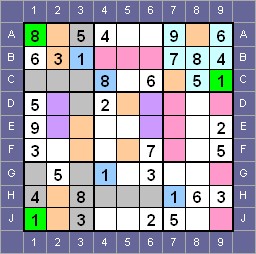|
|
Step-by-Step Solutions...
Sample
Problems General Information
Step-by-step solutions are provides for easy, medium, hard, and extreme
Sudoku puzzles. The intent is to clarify the selection and application
of the strategies presented earlier in the book, primarily in Chapters 2
through 5.
The approach taken with the step-by-step solutions is to use strategies
that are appropriate to the level of development associated with the
difficulty level of the puzzle.
The step-by-step solution boards are presented in the actual sequence I
used to solve the puzzles. I can only describe one path to the solution,
and it is not necessarily the fastest or most efficient path. I
sometimes jump between strategies when solving these puzzles. While I
advocate a systematic approach, I also advocate solving cells as soon as
a solution becomes apparent since solving cells often helps solve other
cells. If you try to solve the puzzle yourself and follow a different
path, your solution will be equally valid as long as your logical
process is correct.
The approach I advocate involves selecting a group and working to find
the solution to cells within the group or working to find the location
of a target number in the group. The group selected for analysis is
highlighted. An exception is the Box Exclusion strategy where
highlighting the box is not practical since gray shading is used to
indicate cells that cannot contain the target number in the box. The
shading starts from the target number being used, which is shaded in
blue, and extends to the box being checked.
For row, column, and box check strategies, filled cells that are helpful
in reducing possibilities are highlighted in yellow.
When a solution is found, the cell is shaded green and the solution
number is placed into the cell.
Once a strategy has been applied to solve a cell, other cells may become
immediately solvable using the single possibility strategy and taking
advantage of available clues. Solutions that follow from the clues are
shaded green but the cell solutions are not filled in. This is done to
allow you to better understand how the clues are used to find these
additional solutions.
In the sidebar I describe the primary strategy used for each diagram and
may include hints regarding the position. On diagrams where multiple
solutions can be found, cell solutions are listed in the order that they
occur. The next diagram will contain all the solutions from the previous
diagram. I recommend that you work through these solutions yourself to
see how the clues get used to find solutions.
Other cells of interest are shaded in different colors to indicate cells
that formed a pattern such a naked pairs, triples, quads, or constraints
or cells where the clues were updated.
Easy Puzzles
Easy puzzles are solved using the Single Possibility strategy from
Chapter 2 and using the Row Check, Column Check, and Box Check
strategies from Chapter 3.
Medium Puzzles
In solving the medium difficulty puzzles, I use only the strategies
presented in Chapters 2 and 3, plus the Naked Pairs strategy covered in
Chapter 4.
Hard Puzzles
Hard puzzles are solved using the strategies from Chapters 2 through 5.
I use the Box Exclusion strategy first and try all target numbers and
check all boxes, unless I see rows, columns, or boxes with fewer than
four empty cells. I check those positions using the Row, Column, and Box
Check strategies.
Extreme Puzzles
Extreme puzzles are solved using the same approach as medium and hard
puzzles, with the Box Exclusion and Row, Column, and Box Check
strategies the most useful to get started. With extreme puzzles you will
more rapidly reach a point where you need the Pairs, Triples and Quads
strategies from Chapter 4. The constraint strategies in Chapter 5 can be
very useful as an extra tool to help find solutions. The more advanced
techniques presented in Chapters 6 through 11 are only required on a few
occasions for the most difficult puzzles after all other strategic
options have been tried.
Iíve included more extreme
puzzle solutions than any other level since they are more interesting
and varied, and of course more difficult with fewer branches that lead
to the solution.
The extreme solutions make very little use of the advanced patterns from
Chapters 6 through 11 because they patterns are not usually required by
the puzzles published in newspapers and magazines.
|

Sample Problems
Easy
Medium
Hard
Extreme 1
Extreme 2

Descriptive Color
Scheme
To aid in understanding, the following color scheme
is used in the diagrams:
- A group of interest is shown in pale blue
- Cells of interest are shaded pale orange
- Useful cells are shaded pale yellow
- Completed cells are shaded green
- Excluded cells are shaded gray
- Target number cells are shaded blue
- Pairs are shaded rose
- Triples are shaded rose
- Constraints are shaded blue
- Extreme strategy cells are shaded red
- Exclusion cells are shaded pale orange
Note: pairs may
also be shaded pale orange or yellow to distinguish
from other subsets
|
|
